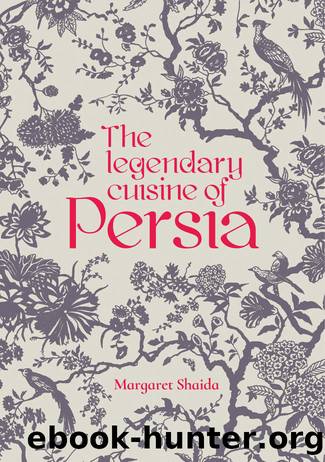The Legendary Cuisine of Persia by Margaret Shaida

Author:Margaret Shaida [Неизв.]
Language: eng
Format: epub
Tags: COOKING / Regional & Ethnic / Middle Eastern
ISBN: 9781911621591
Publisher: Casemate Publishers & Book Distributors, LLC
Published: 2022-03-31T21:00:00+00:00
Orange stew
KHORESHT-E NRANJ
Oranges, known by the ancient Persians as nârang have been grown in the Caspian region for at least two thousand years. After the Arab conquest of Iran, these oranges found their way along the Mediterranean shores and up into Spain. The Arabs called them nâranj (not having a hard âgâ in their alphabet) while the Spaniards called them naranja, and the French orange. These early oranges were all very sour.
It was not until the early sixteenth century that the sweet orange became known both in Persia and in Europe, when the early Portuguese explorers first brought it from China. Stopping off to pick up provisions at the Persian Gulf port of Hormoz, the Portuguese traded spices and sweet oranges from the East for water and provisions. Despite the hot and arid climate of the Persian Gulf, the new fruit trees did rather well in the nearby desert oases. Today, the sweet and juicy oranges of the oasis town of Bam acknowledge their history in their name of portoghâl.
Today, the sour nâranj is available in England for only a brief few weeks in January, when it appears as the Seville orange for marmalade making. It can however be found in Iranian stores throughout February and even into March.
In Iran, there are still two distinct fruits available in the winter months: the sharp nâranj and the sweet portoghâl. The Old Persian name is still recalled in the tangerine, which is known as nârangi or âorange-colouredâ.
However, the Persians never let the easy charms of the sweet portoghâl blind them to the attractions of the nâranj. The nâranj blossoms are so deliciously perfumed they are made into a delicate jam, its aromatic skin is dried for use in flavouring rice dishes and stews, and its wonderfully sharp juice is used in beverages and desserts or to give a lift to fried fish and meat patties, soups and pastes. The whole fruit is steeped and preserved in syrup; it is made into jams and marmalades, slices are used for garnishing sweet and savoury dishes. For the Persians, the nâranj is irreplaceable. The portoghâl, though delicious, is just one of many seasonal sweet and juicy fruits.
The sour nâranj or Seville orange is preferable for this classical stew from the orange groves of the northern provinces. If sweet oranges are used, add lemon juice. It alters the flavour slightly, but is still a very pleasing and rather special dish.
Download
This site does not store any files on its server. We only index and link to content provided by other sites. Please contact the content providers to delete copyright contents if any and email us, we'll remove relevant links or contents immediately.
Biscuits: A Savor the South Cookbook by Belinda Ellis(4215)
A Jewish Baker's Pastry Secrets: Recipes from a New York Baking Legend for Strudel, Stollen, Danishes, Puff Pastry, and More by George Greenstein(3449)
BraveTart by Stella Parks(3306)
Bake with Anna Olson by Anna Olson(3278)
Panini by Carlo Middione(3160)
Nigella Bites (Nigella Collection) by Nigella Lawson(3095)
Momofuku by David Chang(3052)
Modern French Pastry: Innovative Techniques, Tools and Design by Cheryl Wakerhauser(3028)
Bread Revolution by Peter Reinhart(2989)
The Bread Bible by Rose Levy Beranbaum(2887)
Best of Jane Grigson by Jane Grigson(2869)
Classic by Mary Berry(2833)
Sweet by Ottolenghi Yotam & Goh Helen(2804)
Martha Stewart's Baking Handbook by Martha Stewart(2676)
Flavor Flours by Alice Medrich(2643)
Betty Crocker's Good and Easy Cook Book by Betty Crocker(2598)
Sweet by Valerie Gordon(2267)
Baking by Hand by Andy King(2128)
Taste of Home Brownies & Bars by Editors at Taste of Home(2042)
